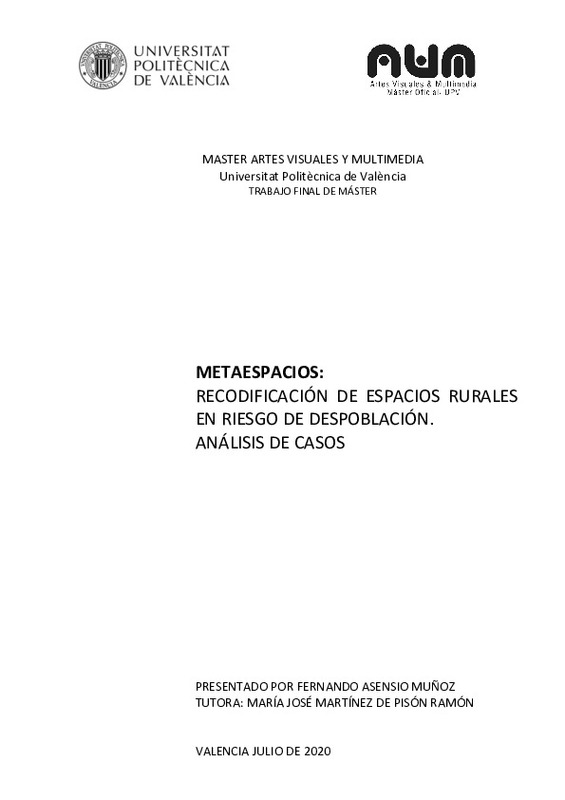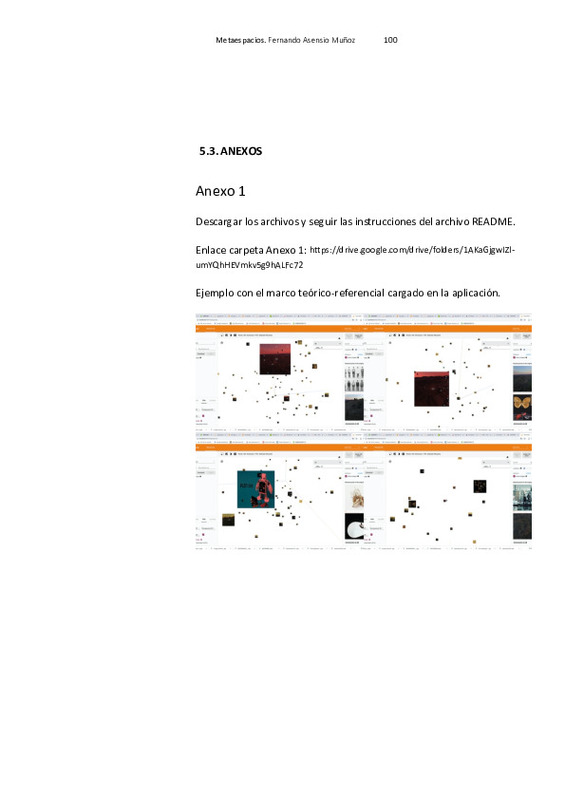JavaScript is disabled for your browser. Some features of this site may not work without it.
Buscar en RiuNet
Listar
Mi cuenta
Estadísticas
Ayuda RiuNet
Admin. UPV
Metaespacios: Recodificación de espacios rurales en riesgo de despoblación. Análisis de casos
Mostrar el registro sencillo del ítem
Ficheros en el ítem
| dc.contributor.advisor | Martínez de Pisón Ramón, M. José
|
es_ES |
| dc.contributor.author | Asensio Muñoz, Fernando
|
es_ES |
| dc.date.accessioned | 2020-09-04T10:13:52Z | |
| dc.date.available | 2020-09-04T10:13:52Z | |
| dc.date.created | 2020-07-29 | |
| dc.date.issued | 2020-09-04 | es_ES |
| dc.identifier.uri | http://hdl.handle.net/10251/149425 | |
| dc.description.abstract | [ES] Este proyecto de investigación en práctica artística se inserta en las líneas de investigación del máster: Prototipado y Fabricación Electrónica, y Activismo e Interfaces Críticas. Su objetivo principal es explorar algunas de las posibilidades de la tecnología de inteligencia artificial y el machine learning (IA y ML de aquí en adelante) aplicada al campo del Arte de los nuevos medios, para representar el small data (Ortiz 2018) que queda como remanente en las zonas rurales en riesgo de despoblación y los entornos naturales que las rodean. El proyecto se concreta en una escultura robótica interactiva. Este trabajo también forma parte del primer año de los estudios de doctorado, por lo que en esta memoria se expondrá un primer caso de estudio (caso II) de la siguiente serie de 5 que serán abordados durante la investigación de dicha tesis: -Caso I: Zona deshabitadas. -Caso II: Zona en riesgo de despoblación. -Caso III: Pueblo de colonización -Caso IV: Espacio natural -Caso V: Zona rural fuera de España El desarrollo de la instalación busca establecer una relación emocional con los datos que desaparecen de las áreas rurales en riesgo de despoblación (caso II) representadas en este caso por la localidad de Pozuel del Campo (Teruel). Para ello se realizará un proceso de datificación del objeto de estudio consistente en una serie de entrevistas a una de sus exiliadas, Angeles Gregorio, además de una investigación audiovisual de campo. La instalación interactiva girará en torno a una escultura robótica. La interactividad de esta instalación estará configurada mediante técnicas de M.L. y el entorno audiovisual de la obra será generado, en parte, con herramientas I.A., a partir de los datos de campo recopilados en distintos lenguajes de codificación, resultando de este proceso de reflexión y práctica documentada, las bases de un nuevo espacio de hibridación entre individuos, colectivos y tecnología. | es_ES |
| dc.description.abstract | [EN] The overall aim of this research project in artistic practice, is inserted in the research lines of this master degree, Prototyping and Electronic Manufacturing, and Activism and Critical Interfaces. Thus, it will try to explore some of the possibilities of artificial intelligence technology and machine learning (AI and ML from now on) applied to the field of New Media Art, to represent the small data (Ortiz 2018) that remains as a remnant in the rural areas at risk of depopulation and its natural surroundings. The project materializes into an interactive robotic sculpture. This work is also part of the first year of doctoral studies, so this master thesis will present a first case study (case II) of the following series of 5 that will be addressed during the research of said thesis: -Case I: Uninhabited area. -Case II: Zone at risk of depopulation. -Case III: Colonization town -Case IV: Natural space -Case V: Rural area outside of Spain The development of the installation seeks to establish an emotional relationship with the data that disappear from rural areas at risk of depopulation (case II) represented in this case by the location of Pozuel del Campo (Teruel). For this, a datification process of the object of study is carried out consisting of a series of interviews with one of his exiles, Angeles Gregorio, in addition to an audiovisual field investigation. The interactive installation will be about a robotic sculpture. The interactivity of this installation will be configured using ML and the audiovisual environment of the work will be generated, partialy, with AI tools, from the data field collected in different coding languages, resulting from this process of reflection and documented practice, the foundations of a new space of hybridization between individuals, groups and technology. | es_ES |
| dc.format.extent | 114 | es_ES |
| dc.language | Español | es_ES |
| dc.publisher | Universitat Politècnica de València | es_ES |
| dc.rights | Reconocimiento - No comercial (by-nc) | es_ES |
| dc.subject | Despoblación | es_ES |
| dc.subject | Recodificación | es_ES |
| dc.subject | Inteligencia artificial | es_ES |
| dc.subject | Machine learning | es_ES |
| dc.subject | Small data | es_ES |
| dc.subject | Depopulation | es_ES |
| dc.subject | Recoding | es_ES |
| dc.subject | Artificial intelligence | es_ES |
| dc.subject.classification | PINTURA | es_ES |
| dc.subject.other | Máster Universitario en Artes Visuales y Multimedia-Màster Universitari en Arts Visuals i Multimèdia | es_ES |
| dc.title | Metaespacios: Recodificación de espacios rurales en riesgo de despoblación. Análisis de casos | es_ES |
| dc.type | Tesis de máster | es_ES |
| dc.rights.accessRights | Abierto | es_ES |
| dc.contributor.affiliation | Universitat Politècnica de València. Departamento de Pintura - Departament de Pintura | es_ES |
| dc.description.bibliographicCitation | Asensio Muñoz, F. (2020). Metaespacios: Recodificación de espacios rurales en riesgo de despoblación. Análisis de casos. http://hdl.handle.net/10251/149425 | es_ES |
| dc.description.accrualMethod | TFGM | es_ES |
| dc.relation.pasarela | TFGM\135406 | es_ES |







